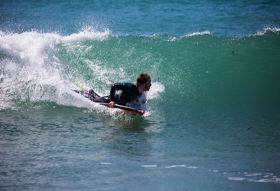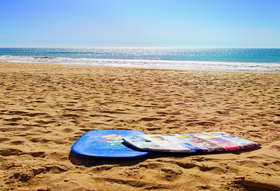
Foam bodyboards

In the summer months, us Brits find ourselves racing to the seaside, and in turn, sales of water sports equipment such as body boards also skyrocket. Bodyboarding – also known as boogieboarding – is a type of water sport that differs from surfing, where an individual uses a specialist board to ride the crest, face and curl of a wave to the shore. Unlike surfing, which usually takes many years to master, bodyboarding is a beginner-friendly seaside activity for both adults and children alike.
Depending on your experience levels and frequency of activity, there are a number of considerations before purchasing your first board. For example, for children, most body boards easily found in retail stores by the coast are often made from polystyrene which is then covered in a mesh fabric skin. These skins are usually decorated with patterns and drawings, hence their popularity with children, however larger boards of this type are available for adult beginners. These boards can be fragile due to their softer nature, but this makes them more suitable for the amateur boarder. In comparison to polystyrene, EVA foam boards can tackle larger waves, and are a better solution.
For more advanced participants, boards are available made from polyethylene and combined foams, which are then accurately matched to an individual’s skill level. Favoured by many skilled bodyboarders, lightweight and durable polyethylene is a popular choice as boards made from this material can be constructed from solid foam or have a smooth underside. Furthermore, these polyethylene boards can be adjusted for more advanced riders – namely though changes in stiffness – but offer some flexibility for those who prefer some bend in their board.

Combination boards are the most popular for the professional boarder, and are typically made from both EVA foam and polyethylene. In addition to the lower density and flex capabilities of polyethylene, EVA foam works well in low-temperatures, adding toughness and stress resistance. It is this durability that also makes EVA-based and polyethylene bodyboards a reliable choice to be used year on year, as it also has significant adhesive water proof properties and UV radiation resistance.
There may come a time when you need to consider replacement materials for your bodyboard, and there are several options. You may wish to pay retail price for a ready-made bodyboard from a dedicated supplier and pay retail price. Alternatively, you may decide to contact a specialist supplier such as eFoam with your exact requirements before taking your foam to a specialist for finishing and outer covering. Naturally, there are a number of things to consider when refurbishing your bodyboard, or when having one custom made, but this excellent guide from eBodyboards illustrates how to measure and account for your required foams, materials, and components. At eFoam, we are experts in providing foam cut to size for a huge range of applications.
Should you require any assistance on the appropriate foam types for bodyboards, or indeed any other water-based foam devices and buoyancy aids, please contact us.

